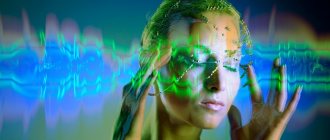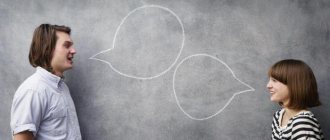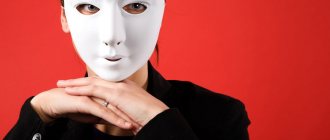Oral or written speech helps a person convey his feelings and thoughts to others. In the first case, not only voice transmission of text is used, but also non-verbal means of communication, such as gestures or facial expressions. They enliven speech, giving it a more emotional coloring. The ability to correctly read nonverbal signals allows you to understand the true motives of your interlocutor, since it is facial expressions in communication that express a direct attitude to what is happening.
The meaning of facial expressions in human life
Nonverbal communication does not involve the use of speech, only sensory or bodily contacts: facial expressions, touch, gestures, gaze. They are the ones who help people achieve mutual understanding at the emotional level. Research has found that we transmit only 35% of information to each other through speech. The remaining 65% comes from non-verbal signals: body movements, gestures, gaze, facial expressions. They complement spoken phrases, enhancing their significance.
In fact, nonverbal communication is quite capable of replacing speech. This is what happens to deaf-mute people. For them, nonverbal communication through gestures and facial expressions is a common way of communicating with others. The same can be said about children who have not yet learned to speak. People use nonverbal communication techniques to establish communication connections with representatives of the animal world.
The importance of facial expressions in the communication process cannot be underestimated. After all, sometimes a facial expression, coupled with other nonverbal signals, carries more information about the feelings or mood of the interlocutor than words. People are used to controlling what they say. However, nonverbal manifestations are difficult to hide. Many movements occur reflexively, before the emotion is evaluated by the brain. By learning to capture and interpret facial expressions and other nonverbal signals, you can understand not only what the interlocutor wants to say, but also what he is trying to hide.
Secrets of facial microfacial expressions
Different facial expressions on a girl
To learn how to read people's thoughts from their faces, you need to understand how a person's facial expressions and his consciousness are connected. Micromimicry is a person’s emotional reaction, which finds its manifestation in the slightest movements of our face. Nonverbal psychology studies this relationship. According to her theory, there is verbal communication, that is, real, and there is nonverbal communication - without using language, but with the help of facial expressions, gestures and voice intonation.
A person’s thoughts and his facial expressions are inextricably linked; moreover, contraction of the facial muscles occurs both voluntarily and involuntarily, so sometimes we are not able to fully control our emotions, which are clearly visible on the face. Your ability to read the thoughts and feelings of your interlocutor and the effectiveness of your communication depend on good knowledge and practice. You should be especially careful when facial expressions do not correspond to a person’s words, because this already indicates the slightest manifestation of a lie.
Expressions of feelings and emotions through nonverbal signals
Gestures, pantomime and facial expressions are means of communication that are classified as optical-kinetic. This system of nonverbal signals includes appearance, voice timbre, hand or head movements, and body position in space. Successful establishment of contact depends not only on what the interlocutor says, but also on how confident his facial expressions, posture, voice, and gaze are. This is what explains the interest in studying the meaning of nonverbal signals on the part of psychologists, businessmen and people who want to build a career.
What will facial expressions tell you?
The most important element of nonverbal communication is facial expressions. American psychologist Paul Ekman developed the Facial Affect Scoring Technique, or FAST for short, which allows you to visually determine the patient’s emotional state. The professor suggested conditionally dividing a person’s face into three zones:
- forehead and eyes,
- nose and area around it,
- mouth and chin.
According to the FAST method, the meaning of nonverbal facial expressions is considered only in the totality of changes in at least two of these areas. Such a simple analysis of a non-verbal signal allows, for example, to distinguish a feigned smile from sincere joy.
There are six basic emotions, most clearly expressed through facial expressions:
- joy,
- anger,
- astonishment,
- disgust,
- horror,
- sadness.
Involuntary or reflexive facial expressions are nonverbal manifestations that the person himself does not control. It is she who reflects the true emotional state.
We propose to consider the most significant non-verbal manifestations of feelings reflected in facial expressions, which are schematically depicted in the picture:
- The emotion of joy is reflected in the area of the forehead and mouth. The corners of the lips are raised, the teeth are slightly open. Light wrinkles appear around the eyes. The eyebrows also rise slightly in relation to the bridge of the nose.
- The face of a person who is experiencing happiness is relaxed. This is expressed by half-closed upper eyelids, slightly raised eyebrows, and a radiant gaze. The corners of the lips are drawn towards the ears.
- Surprise is characterized by raised eyebrows, rounded eyes, and a slightly open mouth.
- Doubt is expressed in a person’s gaze shifted to the left. It is the left hemisphere of the brain that is responsible for analyzing the situation. The position of the lips resembles a sarcastic grin, that is, only one edge of the lips is raised.
- Sullenness or despondency is expressed by drooping eyebrows and corners of the mouth. The look is dull, indifferent.
- The face of a frightened man is tense. Fear is expressed in raised eyebrows and wide eyes. Teeth are partially visible through parted lips.
- shock is expressed by facial expressions .
- A one-sided grin, a sideways glance, narrowed eyes and a raised eyebrow - this is what mistrust looks like.
- The gaze of a person thinking about a problem is directed upward. The corners of the lips are slightly lowered.
- Wide-open, sparkling eyes, raised eyebrows and a slightly open mouth express joy at the brilliant idea that has come to mind .
- A person happy with himself looks relaxed. His eyebrows and eyelids are lowered, and his lips are folded into a half-smile.
- squinted look , raised outer corners of the eyebrows, lips compressed into a string, folding into a tight smile will tell about insidious plans.
- The sly man narrows his eyes and looks away. The left or right corner of his mouth rises.
- Demonstrating determination , a person purses his lips, clenches his jaw tightly, and looks from under his brows. His pupils may narrow sharply, his gaze becomes threatening.
- When embarrassed , people look down and smile with their lips closed so that one corner of their mouth rises. The inner tips of the eyebrows creep up.
- Resentment is expressed in pursed lips, low eyebrows and eyelids. The gaze is directed away from the interlocutor.
- intently , most people move their eyebrows so that a crease forms on the bridge of their nose. At the same time, the gaze seems to be directed inwards, the chin is tense, the mouth is motionless.
- Uncertainty is expressed in a slightly confused, wandering gaze, raised eyebrows. At the same time, the corners of the lips are lowered.
- dreamy expression on the face is characterized by highly raised inner corners of the eyebrows. The gaze is directed upward, the corners of the mouth are located asymmetrically.
- Fatigue is expressed in complete relaxation of the facial muscles, including the eyelids. The lips take on a horseshoe shape, with the tips pointing downwards.
To accurately determine the emotional state by facial expressions or by a combination of non-verbal signs, it is necessary to take into account such details as the direction of gaze and the state of the pupils. If a person experiences strong antipathy towards the interlocutor, he involuntarily squints. A liar averts his eyes to the side; he is betrayed by frequent blinking or, on the contrary, by an unblinking gaze. Insincerity is evidenced by facial asymmetry and too mobile facial expressions.
How to apply knowledge about microfacial expressions?
What does this facial expression mean?
Given that each emotion manifests itself differently, remembering all the features is not so easy. Practice and patience play a big role. Remember the expressions of one emotion, and look for its manifestations in the eyes of your interlocutor. To understand this science, you can even practice on a close friend or loved one. Watching him, draw a conclusion, and then ask whether you were right in your judgments.
If you want to understand a person's thoughts, start with the elementary: look into his eyes! It is this part of our face that is the mirror of the soul. It is almost impossible to fake the sparkle in the eyes, so they testify to a person’s attitude towards the events around him.
Do not forget about the connection between facial expressions, posture and gestures that a person shows. The presence of sincere emotion is manifested in the complete harmony of these non-verbal signs. If an imbalance occurs, this indicates the manifestation of lies.
Possible mistakes:
- The idea that you can understand the emotions of any person. There are people who know how to control themselves and their every move. Often these are “gamblers” or chess players, whose success directly depends on restraint and self-control.
- Generalization. Do not forget about the mentality, culture and nationality of a person. It is difficult to make a German smile, but this does not indicate insincerity, while Americans cannot calmly react to a “stony expression” on their face.
- Jumping to conclusions based on just one emotion. Each person is individual, so it is recommended to get to know the person better before drawing conclusions.
- Recognition of a person’s thoughts is used when communicating with a stranger, a teenage child, a boss or subordinates, and on first dates with the opposite sex. In these situations, it is extremely important to know what the other person is thinking!
Recommendations for performing facial exercises
It is important to perform exercises for the development of facial expressions regularly - only then the psychology of communication and facial expressions will become a faithful assistant. The duration of the workouts varies from person to person, but most often they are performed for 10 to 15 minutes a day. The set of classes can be divided into morning and evening sessions. In addition, there is no urgent need to carry out gymnastics strictly according to the schedule.
Any exercise aimed at mastering facial expressions should be performed in front of a mirror. It is extremely important to take the correct body position. It is most convenient to train your facial muscles while sitting, keeping your back and neck straight. It is worth considering that exercise is a considerable strain on the muscles and can negatively affect the elasticity of the skin in the future. Proper facial care and moisturizing will help prevent wrinkles.
Horizontal wrinkles on the forehead
Usually we see a “creased” forehead in emotional people who, like children, are capable of being surprised by everything at any age. Previously, to smooth out such wrinkles, actresses stuck special patches on their foreheads. But today there are more effective and faster solutions, for example, botulinum toxin to relax muscles plus filler to smooth out the relief.
“Purse-string” wrinkles around the mouth
“Purse-string” wrinkles around the mouth can often be observed in smokers. The first decision here is to quit smoking! The second is face fitness. Just not the one that pumps muscles, but on the contrary, relaxing. Of course, prevention makes sense in the early stages. But if you have already noticed age-related changes, you can involve cosmetology. An effective option is the RecoSMA laser procedure or nanoperforation (the doctor will determine which is right for you). A laser can be considered a preventive measure, but if you need more radical measures, a cosmetologist can recommend a course of fillers, for example, 2-3 procedures of soft Belotero Soft.
Pronounced masticatory muscles
Pronounced chewing muscles often signal suppressed anger: a person seems to be clenching his jaw to restrain himself. Here we need to mention bruxism - paroxysmal contractions of the masticatory muscles that occur periodically during sleep, accompanied by clenching of the jaws and grinding of teeth. But there are other requests for chin correction: men who want to look more brutal and strong-willed often agree to filler injections into the chin - and are very satisfied.
Drooping corners of lips
We most often see drooping corners of the lips in skeptics, in people who are dissatisfied with many things. In addition, drooping corners of the mouth can secretly signal depressive thoughts, giving the face a mournful expression. The cosmetic solution in this case is botulinum therapy and filling with fillers. Moreover, the filler can be injected into the area of retraction, and if there is a lack of volume in the middle third, then there. But the raised corners of the mouth indicate optimism and lightness. Try to smile and you will be considered an optimist!











